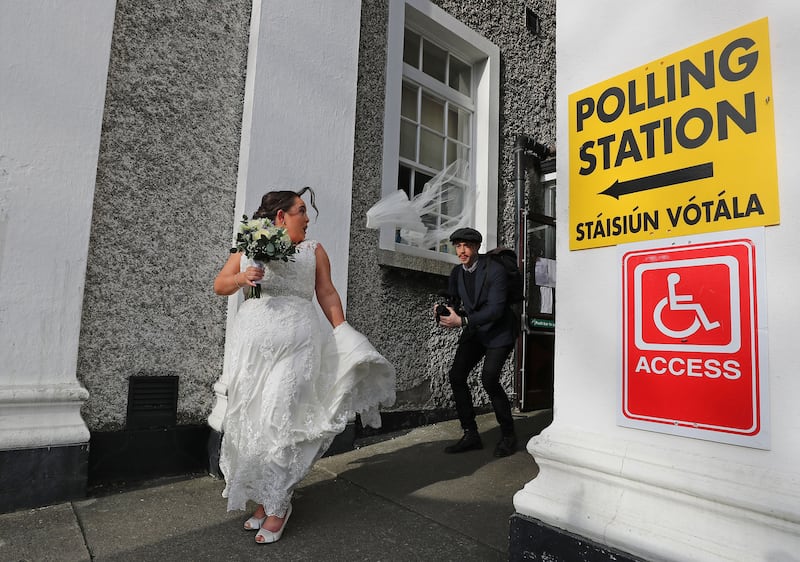If the Irish Times/RTE/TG4 exit poll is borne out by the actual election results, it will result in one of the most dramatic realignments in Irish politics since the foundation of the State almost a century ago.
Up until the 1980s, Fianna Fáil and Fine Gael were supported by well over four-fifths of voters – four decades later, the support levels for the two parties has dropped precipitously. The two parties who between them controlled each and every government now only enjoy the support of a little over two-fifths of the population.
What the exit polls tells us is that there is effectively a three-way tie between Fine Gael, Fianna Fáil and Sinn Féin with only a percentage point separating each of them.

A word of warning while the sample is very large, 5,000 people, the margin of error is 1.3 per cent.
If the parties are equal in terms of percentages, that is not going to work out in terms of seats. Sinn Féin’s percentage of support will not be reflected in the number of seats it wins, purely because it has not run enough candidates.
On these figures, if it had run a second candidate in Dublin South Central, Dublin Central, Dublin South West, Dublin Bay North and Cork North Central it would have had a really good chance of taking a second seat in most of those constituencies, a little like Labour did in 2011 when it had the “Gilmore Gael”.
Sinn Féin
In its wildest dreams in the months before the election, Sinn Féin did not see itself vying with the two big parties for supremacy – hence a very conservative approach to candidate selection based on the belief it might lose seats.
So in terms of comparison, the closest comparator is the Labour Party in 1992, under its then leader Dick Spring. In that election, Labour’s percentage share of the vote leaped from 10 per cent to 20 per cent in what the media dubbed The Spring Tide. However, like Sinn Féin now, the party had not run enough candidates, and ended up with 33, which it could easily have won 40.
It’s going to be similar for Sinn Féin here if these figures are borne out. The party can expect to win about 32 seats if its rise in support levels are consistent all around the country, an increase of ten from its present complement.
Of those you could say that Padraig Mac Lochlainn (a second seat in Donegal); Pauline Tully (a second seat in Cavan-Monaghan); Paul Donnelly (Dublin West); Rose Conway-Walsh (Mayo); Darren O’Rourke (Meath East); Johnny Mythen (Wexford) would be strongly favoured to become TDs. And then others such as Chris Andrews (Dublin Bay South); Mairéad Farrell (Galway West); Sorca Clarke (Longford-Westmeath) and Claire Kerrane (Roscommon-Galway) are all in the frame for a final seat.
You look elsewhere at the other leafy south Dublin constituencies, at the two Kildare constituencies, and in Meath West (where former member Peadar Tóibín is a TD) and it looks less likely. But then in 1992, an unknown candidate Mosajee Bhamjee won a seat for Labour out of nowhere.
In lots of constituencies, the Sinn Féin candidate will top the poll, with a considerable surplus. Sinn Féin voters do not transfer as readily as other parties. But in general, it transfers to left-wing candidates in urban constituencies and (slightly more) to Fianna Fáil in rural constituencies. Mayo would be a good example of that in 2016.
Left-wing TDs
Suddenly, it means the fate of a whole raft of left-wing TDs who were independent or belonged to smaller groups looks more feasible. Solidarity-People Before Profit could end up returning most of its TDs – it’s only when it’s in direct competition with Sinn Féin, such as in Dublin West, that it might lose out.
So what of Fine Gael and Fianna Fáil. Both will return more seats than their percentage should reflect, with a considerable seat bonus of between ten and twenty over Sinn Féin.
Where a relatively unknown Sinn Féin candidate is presenting a threat in a constituency you might see the phenomenon of tactical transferring from one party to the other to keep Sinn Féin out. That might be evident in constituencies like Roscommon-Galway and Longford-Westmeath where Sinn Féin will be duelling with a major party for the last seat.
However, no matter how big the bonus, on these figures neither Fianna Fáil (which looks likely to be the biggest party) or Fine Gael will have any hope of forming a coalition without a new confidence and supply agreement, or else by going in with Sinn Féin. The numbers look uncertain.
Green growth
Fine Gael could be reduced to a single seat in most of its constituencies and without a seat in a number of new constituencies. Fianna Fáil hopes of winning a seat in five Dublin constituencies where it had no representation might need to be modified a little in the light of these figures.
Gains targeted by both parties might need to be jettisoned. Indeed, one or the other is facing losses in constituencies like Wexford, Meath East, Mayo, Galway West, and Dublin Bay South.
The Green party looks like it will become the fourth biggest party on these numbers. The 8 per cent national support is close to the results of the last Irish Times Ipsos MRBI poll which showed it had 16 per cent support in Dublin. If that figure is replicated it has the potential of winning an extra six seats in the capital, and perhaps, one or two around the State. It looks like it will end up with seat numbers close to double figures.
For the Labour Party, it’s not looking so rosy. If the party’s national support level is truly at 4 per cent, it’s going to be difficult for the party to make gains and it could also see one or two of its five outgoing TDs losing their seats, bringing the party close to questions being asked about its future solvency.
At 3 per cent, both the Social Democrats and Solidarity-People Before Profit could both end up with a smattering of seats, with the latter salvaging something from the jaws of defeat.
There was a narrative for the past year that the tide was going out for Independents. But at 16 per cent in this exit poll, if its findings are borne out, it could end returning roughly the same number of TDs as were in the 32nd Dáil.










